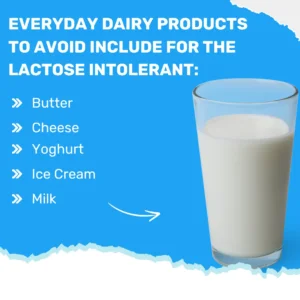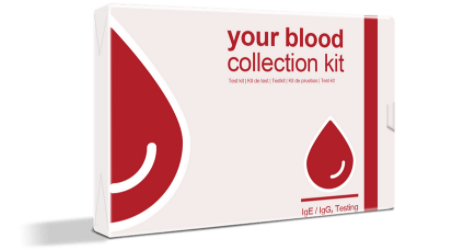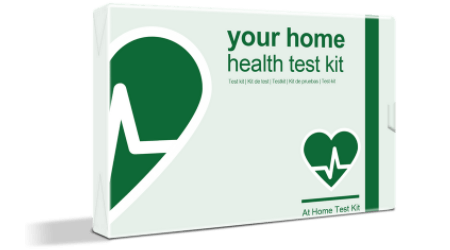Lactose intolerance is caused by the body’s inability to fully digest lactose, a sugar found in milk and dairy products. Lactose intolerance is harmless. However, it can cause uncomfortable digestive symptoms. When consuming dairy products, people suffering from lactose intolerance experience symptoms like diarrhoea, flatulence, and stomach pain.
Millions of people globally suffer from lactose intolerance. It’s among the most common food intolerances. Even though it’s not harmful, it can sometimes be embarrassing, but there are ways around suffering from symptoms.
What is lactose?
Lactose is a sugar present in milk. When you consume dairy products and milk, your body produces lactase, an enzyme whose primary function is to break down this milk sugar. People with lactose intolerance have insufficient lactase enzymes in the small intestines.
Young children whose diet consists primarily of milk produce lots of lactase enzymes to break milk and absorb nutrients into their bodies. However, when these children start weaning, their bodies decrease the quantity of lactase enzymes produced by the small intestines.
As an adult, some people’s quantity of lactase produced by the small intestines keeps decreasing, and eventually, one suffers from lactose intolerance. It’s common for most people to develop lactose intolerance in their adult years or as teenagers.
Even with low lactase levels, one can still digest milk well enough to consume it. However, too much milk or milk products can prove too much for insufficient lactase enzymes to digest.
If you’re curious, you can find out whether you’re lactose intolerant through one of our Intolerance Tests. With the help of a doctor, you can go on an elimination diet, then, later on, add milk into your diet and figure out the quantity of lactose your body can tolerate without causing symptoms. However, most people prefer adopting a lactose-free diet as it’s more straightforward.
How do I know if I am lactose intolerant?
The body reacts in different ways after consuming lactose, which will help you know whether you may be suffering from lactose intolerance. Usually, when you consume lactose products, the small intestines break it down into small molecules and then absorb it into the blood.
However, when you’re lactose intolerant, you have insufficient lactase enzyme, which means your lactose sugar isn’t broken down in the small intestines. Instead, it’s pushed into the colon, where it mixes with normal bacteria and ferments. This also causes the colon to produce much water to help move it out of the body.
This entire colon process causes the production of gas and water retention. In turn, this shows up as bloating, diarrhoea, and gas, which are side effects of lactose intolerance. These and other digestive symptoms aren’t fun at all, but neither are they life-threatening.
Changing one’s diet and preventing suffering from these symptoms is possible. For some people, completely cutting off lactose from the diet does wonders, while limiting lactose products works for others.
What causes lactose intolerance?
Both children and adults can suffer from lactose intolerance. Here are some common causes of lactose intolerance:
- Hereditary: It is common for lactose intolerance to run in families. Most people with hereditary lactose intolerance often experience symptoms over time when the body starts producing fewer lactase enzymes, which causes lactose intolerance to develop. These symptoms of lactose intolerance may begin developing in the early adult or late teen years.
- Diseases or infections: Some people stop producing sufficient lactase enzymes when their bodies produce fewer enzymes. Most people develop lactose intolerance after an injury or infection affecting their small intestines or digestive tract.
- Premature birth: When babies are born prematurely, they don’t produce lactase because the cells that produce these enzymes fully develop in the third trimester. Often, these babies suffer from lactose intolerance for a while before they fully develop and can fully digest milk.
- In rare cases, some people are born unable to make any lactase.
What are the symptoms of lactose intolerance?
Symptoms of lactose intolerance vary from one individual to the next. Most of the time, the symptoms of lactose intolerance can appear within 30 minutes to 2 hours after consuming lactose products. It can also take longer. Common symptoms include:
- Bloating
- Diarrhea
- Gas
- Abdominal pain
- Joint pain
- Fatigue
- Flatulence
- Constipation
The severity of these symptoms will depend on the amount of lactose consumed and your tolerance level to lactose. The fewer lactase enzymes your body produces, the fewer dairy products you’re supposed to consume. Lactose intolerance symptoms may also be due to other underlying conditions. That’s why we recommend seeing a healthcare professional before taking an Intolerance Test.
When you have underlying conditions causing lactose intolerance, it’s common to stop suffering from lactose intolerance once you’ve-you’ve managed those underlying conditions.
How to treat lactose intolerance
The best way to treat lactose intolerance is by changing your diet to include items like lactose-free yoghurt, lactose-free milk, and other non-dairy products. Usually, people with lactose intolerance tend to avoid lactose products. However, one can take over-the-counter lactase pills to help them digest lactose.
You can also choose to switch to plant milk and other non-dairy products. If you go this route, you must ensure these products are fortified with calcium and other necessary nutrients that you’ll need when removing dairy from your diet.
Eliminating dairy products isn’t so hard, considering there are vast lactose-free milk and yoghurt varieties in grocery stores. Everyday dairy products to avoid include:
- Butter
- Cheese
- Yoghurt
- Cream
- Ice cream
- Milk
It’s also common to find lactose in some processed foods like:
- Protein shakes
- Cereals
- Baked goods
- Sauces and salad dressings
The best way to avoid lactose is by carefully reading the ingredient lists of any food you purchase. Lactose intolerance also tends to affect people of a certain descent, like Asian Americans, African Americans, Native Americans, and Mexican Americans.
Final thoughts
Lactose intolerance is the most prevalent food intolerance affecting many people worldwide. The easiest way to diagnose it is by taking an Intolerance Test. Once you’ve had your results and know that you are lactose intolerant, you can choose to consume lactose-free items like lactose-free yoghurt and milk.



